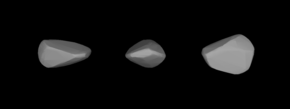Pittsburghia is an asteroid that is in orbit around the Sun 150 million miles from Earth. It is named in honor of the city of Pittsburgh, Pennsylvania, and its scientific and industrial heritage that produced some of the finest astronomy equipment of the time [1].
 A three-dimensional model of 484 Pittsburghia based on its light curve | |
| Discovery | |
|---|---|
| Discovered by | Max Wolf |
| Discovery site | Heidelberg |
| Discovery date | 29 April 1902 |
| Designations | |
| (484) Pittsburghia | |
| Pronunciation | /pɪtsˈbɜːrɡiə/ |
| 1902 HX | |
| Orbital characteristics[1] | |
| Epoch 31 July 2016 (JD 2457600.5) | |
| Uncertainty parameter 0 | |
| Observation arc | 113.95 yr (41620 d) |
| Aphelion | 2.8208 AU (421.99 Gm) |
| Perihelion | 2.5141 AU (376.10 Gm) |
| 2.6674 AU (399.04 Gm) | |
| Eccentricity | 0.057501 |
| 4.36 yr (1591.3 d) | |
| 344.592° | |
| 0° 13m 34.464s / day | |
| Inclination | 12.512° |
| 127.276° | |
| 191.618° | |
| Physical characteristics | |
| 15.805±1.05 km | |
| 10.63 h (0.443 d) | |
| 0.2012±0.030 | |
| 9.86 | |
References
edit- ^ "484 Pittsburghia (1902 HX)". JPL Small-Body Database. NASA/Jet Propulsion Laboratory. Retrieved 6 May 2016.
External links
edit- 484 Pittsburghia at AstDyS-2, Asteroids—Dynamic Site
- 484 Pittsburghia at the JPL Small-Body Database